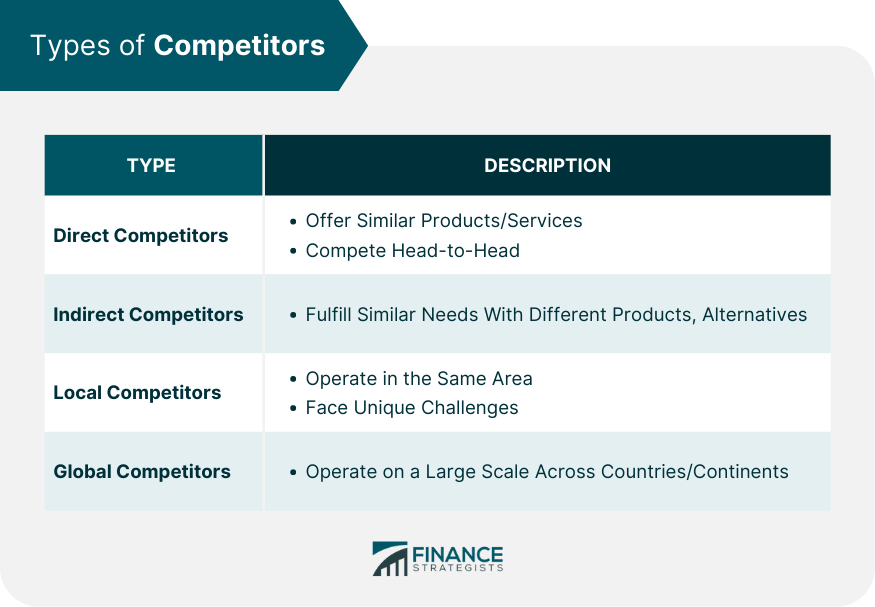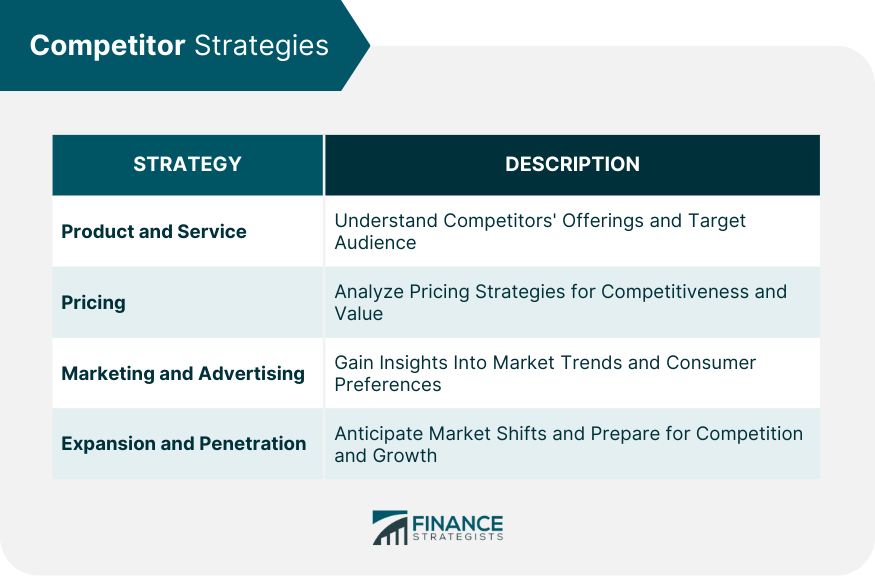A competitor is a rival business whose activities have the potential to reduce another business's share of the market. A competitor who sells the same or a nearly-identical product or service is a "direct" competitor, such as Pepsi and Coca-Cola. A competitor who sells a different product or service which fulfills the same need is called an "indirect" competitor, such as Chipotle and Chick-fil-A. Due to the law of supply and demand, when new competitors enter a market, the supply curve moves to the right, causing a decrease in the price customers are willing to pay per unit of product. Competition is the cause of two things that make economies flourish: innovation and affordability. To retain market share, competitors must either differentiate their offerings through innovation and brand perception or through lower prices. They challenge each other by offering improved services, better pricing, or enhanced products, all with the goal of maximizing profits and establishing dominance in the market. Direct competitors are companies that offer similar products or services to the same target market, and they compete directly for the same customer base, often resulting in head-to-head competition in terms of pricing, features, and marketing strategies. Indirect competitors are businesses that may not offer identical products or services but fulfill similar customer needs or desires, creating a substitute or alternative option for consumers. They indirectly impact the demand and market share of the primary company's offerings. Local competitors are businesses or entities that operate within the same geographical area or region. Often, these businesses target a similar local clientele and deal with challenges unique to their locale, such as local regulations, culture, or consumer preferences. The competitive landscape at a local level can be fierce, especially in densely populated areas, where multiple businesses might be targeting a limited consumer base. On the bright side, local competitors often have a better understanding of the cultural and social nuances of their market. They can adapt quickly, offer localized products or services, and create personalized experiences that resonate with their target audience. Unlike local competitors, global competitors operate on a much larger scale, spanning countries or even continents. They often have a broader reach, extensive resources, and the ability to influence larger markets. With their vast resources, they can tap into various markets, leverage economies of scale, and even influence market trends. Key indicators like revenue growth, profit margins, return on equity, and debt levels offer insight into a company's financial health and its operational efficiency. By benchmarking these metrics against industry averages and direct competitors, businesses can gauge their standing in the market and identify areas needing improvement. A deeper dive into these metrics can also unveil operational strategies, potential vulnerabilities, and opportunities that competitors might be overlooking. Such insights can be invaluable for strategic planning and forecasting. By assessing a competitor's market share, businesses can understand their relative position and the threat posed by other players. A declining market share might indicate dwindling customer loyalty, while a growing share could signal effective marketing strategies or product superiority. Moreover, shifts in market share can predict future industry trends, providing proactive companies with a chance to adapt and innovate before they find themselves on the back foot. Every company has its strengths—something that sets it apart from its competitors. By identifying these unique advantages, whether it's a patented technology, an unparalleled distribution network, or exceptional customer service, businesses can gain insights into why customers might choose one company over another. It's equally crucial for businesses to recognize their own competitive advantages. Harnessing these strengths while addressing weaknesses ensures a stronger position in the market, ready to face competitors head-on. Understanding the range and depth of a competitor's product or service offerings can shed light on their market strategy and target audience. By evaluating the features, quality, and user reviews of these offerings, companies can identify gaps in their products or potential areas for improvement, ensuring they remain competitive and responsive to market demands. Price can be a significant factor influencing consumer choices. Some competitors might adopt a premium pricing strategy, positioning their brand as a luxury or high-quality option. Others might focus on cost leadership, aiming to provide value-driven solutions at competitive prices. By understanding competitors' pricing strategies and the rationale behind them, businesses can adjust their pricing models, offer promotions, or bundle services, ensuring they provide compelling value propositions to their customers. How a company markets itself can say a lot about its brand identity, target audience, and strategic goals. By analyzing competitors' marketing campaigns, advertising channels, and promotional tactics, businesses can gain insights into market trends and evolving consumer preferences. Such an understanding can guide companies in crafting effective marketing strategies, ensuring they remain relevant and resonate with their target demographic. Companies always aim to grow, whether by entering new markets, targeting new demographics, or launching new product lines. By keeping an eye on competitors' expansion plans, businesses can anticipate market shifts, prepare for increased competition, or even identify partnership opportunities. This forward-looking approach enables proactive strategy development, ensuring companies aren't caught off guard by competitors' moves. In the face of competition, it's essential for businesses to reinforce their unique value proposition. By emphasizing what sets them apart—whether it's quality, innovation, service, or price—companies can ensure they remain top-of-mind for consumers. Clear and consistent competitive positioning not only builds brand loyalty but also acts as a barrier against competitors trying to encroach on a company's market share. By forming strategic alliances or partnerships, companies can pool resources, share risks, and access new markets or technologies. Such collaborations can provide a competitive edge, enabling companies to offer something truly unique in the market. However, it's crucial to ensure that these partnerships are symbiotic, with clear terms and shared goals, to maximize their potential benefits. In the ever-evolving business landscape, innovation is key to staying ahead of competitors. Investing in research and development (R&D) ensures that companies remain at the forefront of industry advancements, ready to introduce groundbreaking products or services. Fostering a culture of innovation and continually seeking improvements allow businesses to ensure they're not just reacting to competitors but setting the pace in their industry. Investors will often use direct competitors to compare and contrast financial statements and ratios. Creating an analysis of an industry by examining the ratios of a group of competitors is called financial benchmarking and can help an investor detect outliers who may be over or underpriced. Starbucks is an example of a competitor that gained market share by differentiating itself through brand perception, rather than on price. Generic breakfast cereals that are similar, cheaper alternatives to larger-brand breakfast cereals are an example of a competitor differentiating themselves with lower pricing. Competitors are one of the 5 C's in marketing: Company, Customers, Competitors, Collaborators, and Climate. Competitors are rival businesses whose activities have the potential to reduce another business's share of the market. Direct and indirect competitors offer diverse approaches to vie for market share. Local competitors encounter distinct challenges and opportunities within their geographic regions, while global competitors leverage vast resources and influence. To succeed in this competitive landscape, companies must conduct thorough competitor performance analysis, comparing financial metrics, assessing market share, and understanding competitive advantages. By comprehending competitor strategies in product offerings, pricing, marketing, and expansion plans, businesses can proactively respond to market changes. Strategic positioning, alliances, and continuous innovation are essential for maintaining a competitive edge. Ultimately, competition fosters growth and compels companies to deliver superior value, benefiting both businesses and consumers in the dynamic world of finance.Define Competitor in Simple Terms
What Does Competition Mean in Finance?
Types of Competitors
Direct Competitors
Indirect Competitors
Local Competitors
Global Competitors

How To Analyze Competitor Performance
Compare Financial Metrics
Analyze Market Share
Assess Competitive Advantage

Competitor Strategies
Product and Service Offerings
Pricing Strategies
Marketing and Advertising Approaches
Expansion and Market Penetration Plans

Responding to Competitors
Competitive Positioning
Strategic Alliances and Partnerships
Innovation and R&D Initiatives

Investors and Direct Competitors
Example of Competition
Conclusion
Competitors FAQs
A competitor is a rival business whose activities have the potential to reduce another business’s share of the market.
Competition is the cause of two things that make economies flourish: innovation and affordability, which means that to retain market share, competitors must either differentiate themselves through innovation and brand perception or through lower prices.
Generic breakfast cereals that are similar, cheaper alternatives to larger-brand breakfast cereals are an example of a competitor differentiating themselves with lower pricing.
Investors will often use direct competitors to compare and contrast financial statements and ratios.
A competitor who sells the same or a nearly-identical product or service is a “direct” competitor, such as Pepsi and Coca-Cola. A competitor who sells a differing product or service which fulfills the same need is called an “indirect” competitor, such as Chipotle and Chick-fil-A.
True Tamplin is a published author, public speaker, CEO of UpDigital, and founder of Finance Strategists.
True is a Certified Educator in Personal Finance (CEPF®), author of The Handy Financial Ratios Guide, a member of the Society for Advancing Business Editing and Writing, contributes to his financial education site, Finance Strategists, and has spoken to various financial communities such as the CFA Institute, as well as university students like his Alma mater, Biola University, where he received a bachelor of science in business and data analytics.
To learn more about True, visit his personal website or view his author profiles on Amazon, Nasdaq and Forbes.











